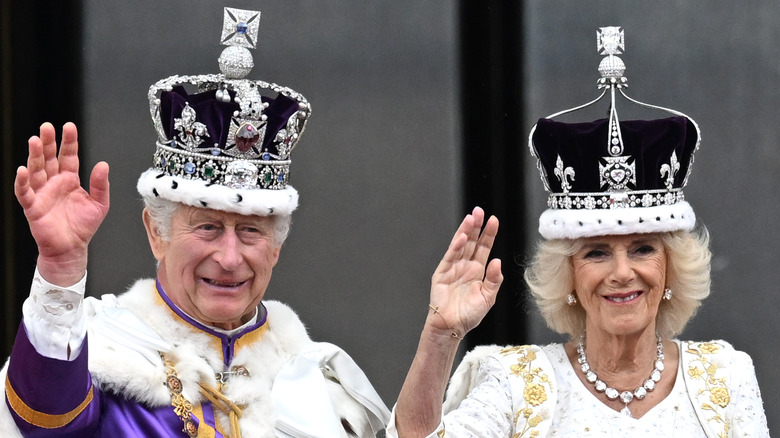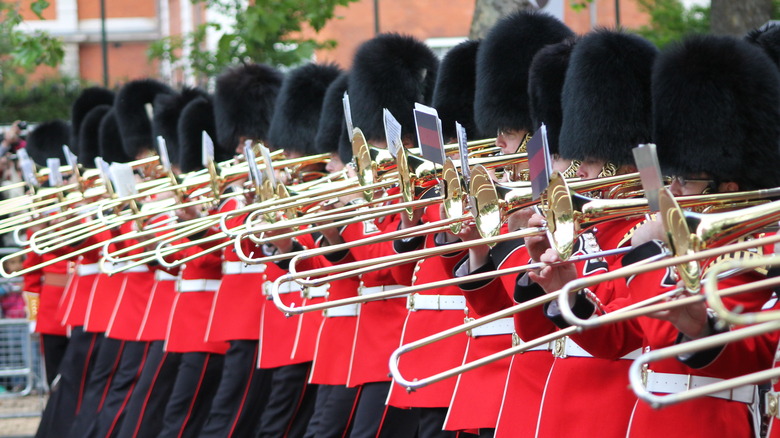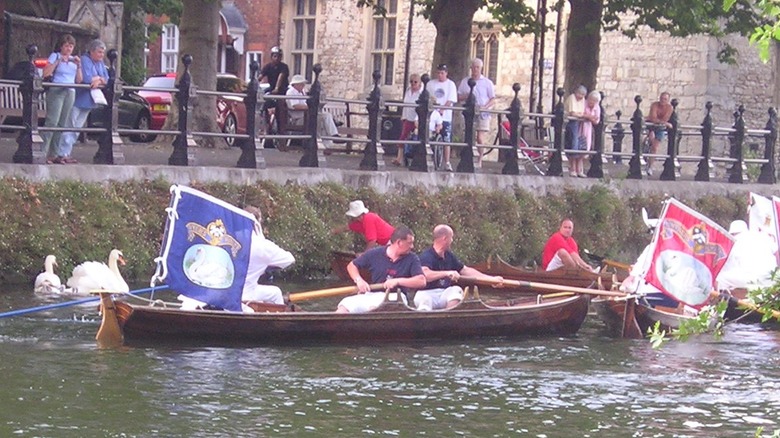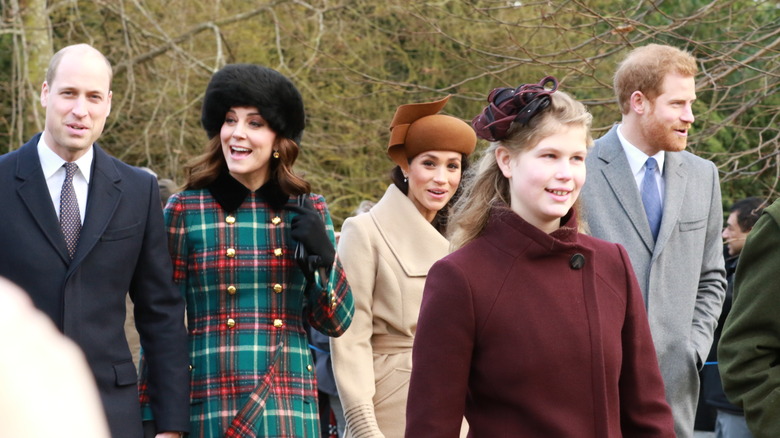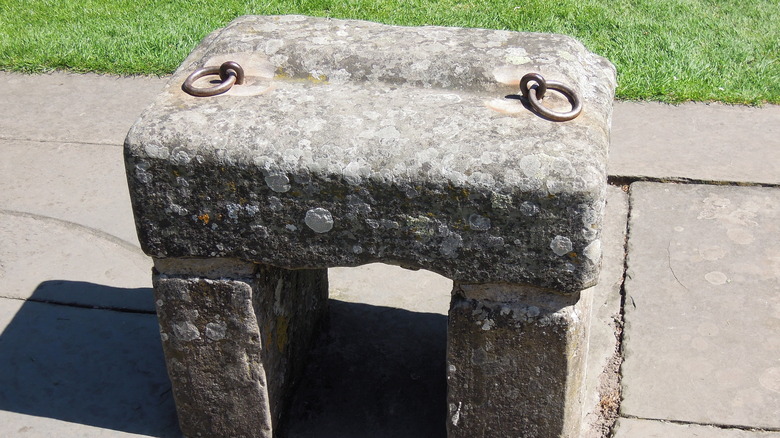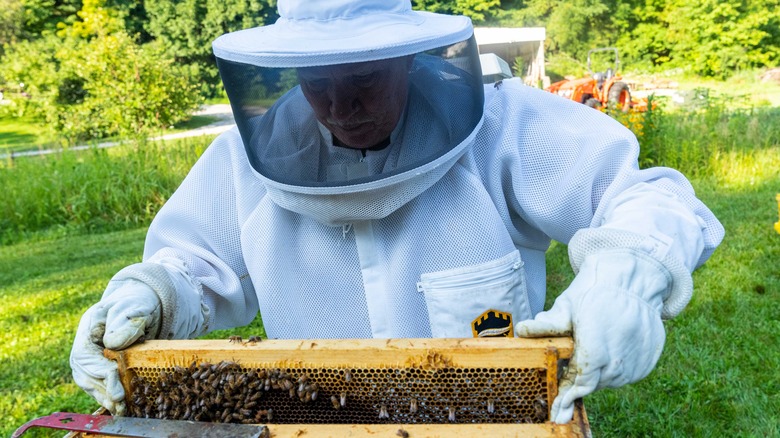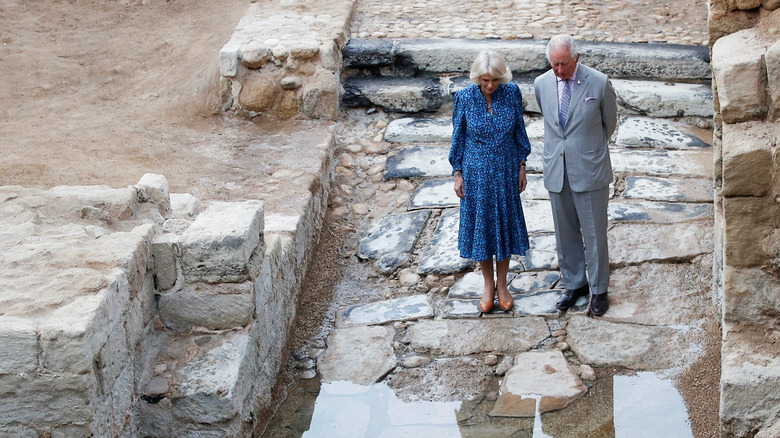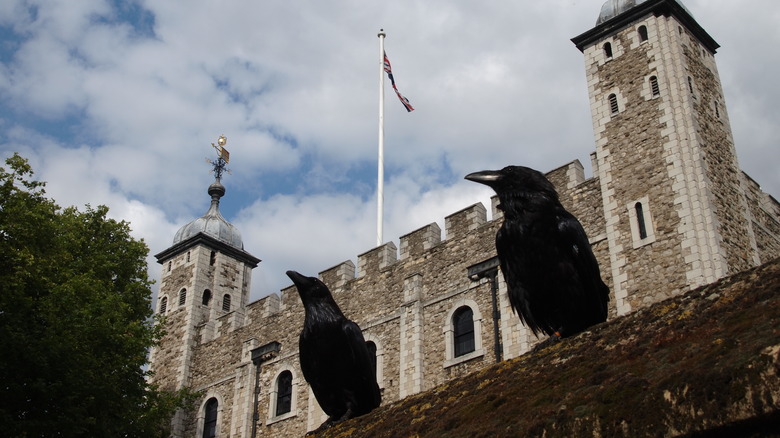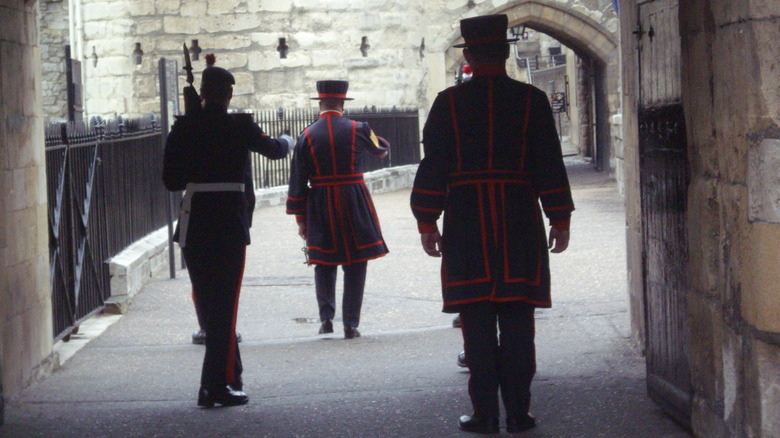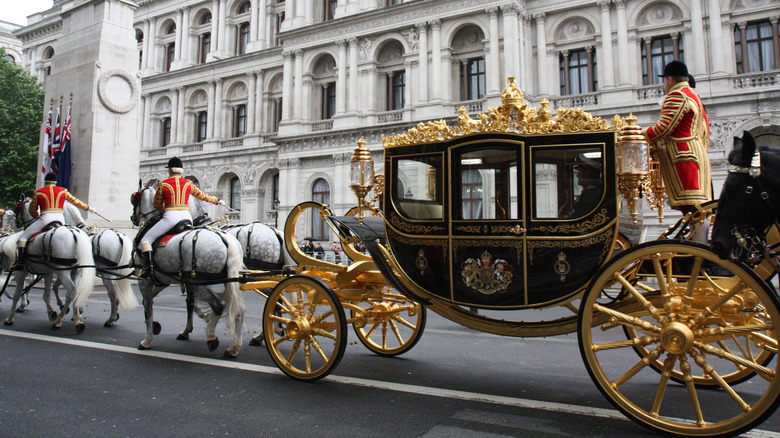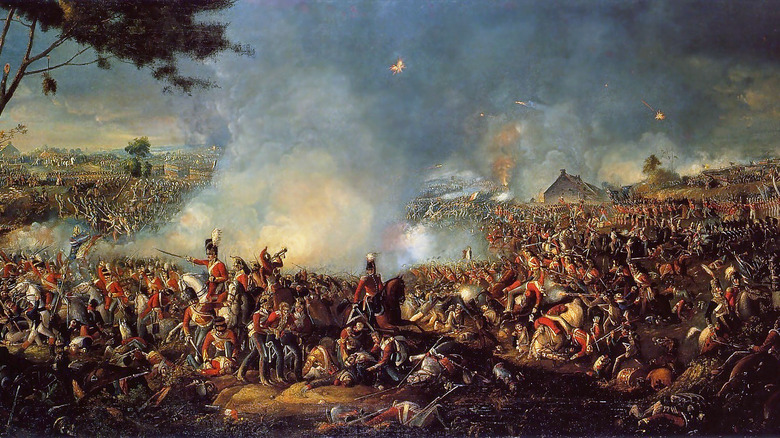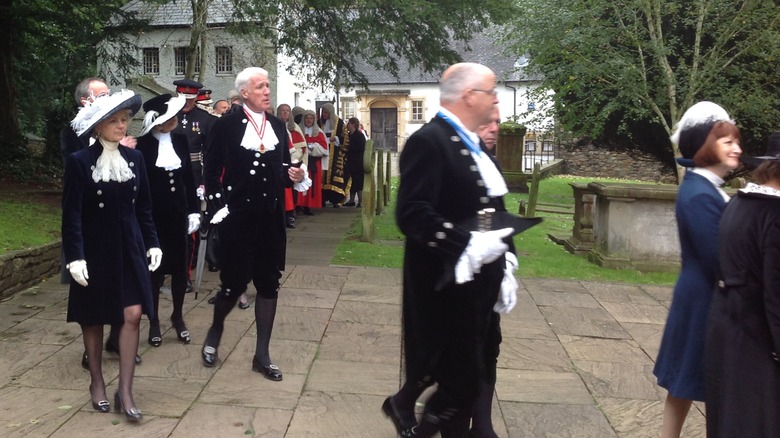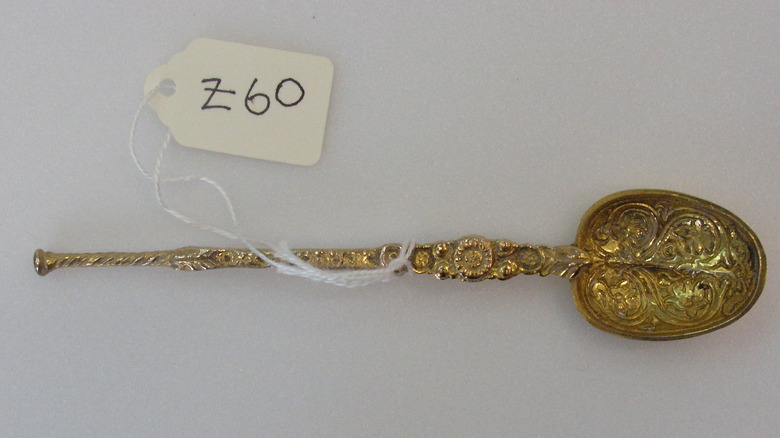Strange British Royal Rituals And Traditions You Probably Don't Know About
The British royal family traces its lineage back to the conquest of England by the Norman duke William the Conqueror in 1066, but there was a line of Anglo-Saxon kings for a few hundred years before that. As a result, there are nearly 1,200 years of history and tradition that the British monarchy — which has outlasted most other European monarchies — takes very seriously.
Any time a tradition is more than a few centuries old, its origins are likely to be shrouded in mystery and lost to the sands of time. As a result, you can end up with a whole mess of extremely strange and random-sounding rituals and traditions, that seem completely normal to the United Kingdom's most famous unemployed celebrity millionaires.
Here are just a few of the odder traditional ceremonies, superstitions, and rituals performed by the British royal family, some of them dating back hundreds of years, and some of them much more modern.
Trooping the Colour
The British royal tradition of "Trooping the Colour" made the news in June 2023, when several soldiers wearing wool uniforms and those big furry hats they're famous for fainted during a rehearsal for the celebratory event, due to high temperatures. But what is this event, and why is it such a big deal that multiple people are willing to pass out for it?
Trooping the Colour is an annual tradition in celebration of the British monarch's official birthday (usually not the same as their actual birthday; Charles III's real birthday is in November), which falls in either May or June. It's a military parade where some 1,400 uniformed soldiers, accompanied by hundreds of horses and musicians, carry ("troop") their flags ("colours") from Buckingham Palace down the Mall, a road in central London.
The practice of Trooping the Colour began during the reign of Charles II in the 17th century, as a way to make sure soldiers remembered what their regimental flags looked like, and it became an annual event to mark the monarch's birthday in the 18th century. Edward VII established the "two birthdays" rule in the first decade of the 20th century so that the trooping could always happen in June, when the weather was nicer than his real birthday in November. The soldiers who passed out from the June heat might disagree with that assessment.
[Featured image by Carfax2 via Wikimedia Commons | Cropped and scaled | CC BY-SA 3.0]
Swan upping
Think fast: can you name who owns all the swans in your home country? If you're British you can. Officially, the British monarch owns all unmarked mute swans living in open waters in the United Kingdom. Since the 12th century, mute swans have been a symbol of royalty in the UK, and at that time, the water bird was seen as a delicacy for which people would pay a high price. Swans purchased from the crown would be marked on their beaks, and each year the swans would be counted to ensure the monarch had enough swans to fill their appetite.
Over time, this procedure evolved into the tradition of swan upping, which occurs each year in the third week of July, when baby swans are old enough to be handled by people. These days, the monarch only claims swans on certain parts of the Thames, and the ceremony is designed for swan conservation, rather than for stocking the pantry.
Teams from the traditional trade guilds of the Vintners and the Dyers, who share ownership of the swans with the crown, row along the Thames in red shirts, rounding up the swans, tagging them, logging a census of their population, checking their health, and then releasing them back into the river. The person whose job is to officially record the swan population is known as the Marker of the Swans.
[Featured image by Philip Allfrey via Wikimedia Commons | Cropped and scaled | CC BY-SA 3.0]
Getting weighed for Christmas dinner
In the 2021 fictionalized biopic of Princess Diana, "Spencer," Diana (portrayed by Kristen Stewart) is shown going to the royal family's Christmas dinner, where everyone in the family is forced to publicly weigh themselves before and after dinner on a pair of antique scales. Since the movie is a heightened account of reality, you might wonder if this practice is real or just a scene to highlight Diana's (real-life) struggles with eating disorders.
According to a 2018 interview with royal expert Ingrid Seward (via Grazia), this embarrassing tradition is all too real, and goes back over 100 years. The ritual of getting weighed before and after dinner dates back to the reign of Edward VII in the 1900s, when he wanted to make sure his guests were truly indulging in the spirit of the holidays. Allegedly the ideal weight gain is 3 pounds.
The rest of the royal holiday routine is highly structured: Presents (typically knick knacks or gag gifts) are given on Christmas Eve, followed by a black-tie dinner where diners sit boy-girl-boy-girl, like in kindergarten. For Christmas Day lunch, the guests enter in order of seniority, eat turkey, and then do normal British Christmas things that seem weird to Americans, like pulling Christmas crackers and wearing paper hats. (Allegedly, Queen Elizabeth never wore a paper hat for Christmas; we'll see if King Charles is more fun.)
[Featured image by Mark Jones via Wikimedia Commons | Cropped and scaled | CC BY-2.0]
The Stone of Destiny
The coronation of King Charles III in May 2023 drew attention to a number of rituals and traditions that hadn't been seen since his mother's coronation, 70 years before. One example of that was the bringing down of the Stone of Scone — also known as the Stone of Destiny — from Scotland. This stone is a 335-pound rock that slots into a hole in a centuries-old chair that has been used for coronations since the 14th century. Prior to that, the stone was used in the coronation of Scottish kings, going back to time immemorial. When Edward I conquered Scotland in 1296, he took the stone from Scotland to represent his dominion over it. Its use in coronations of the monarchs of the United Kingdom serves as a reminder to Scotland that they are, literally, under the English king's heel.
According to legend, the Stone of Scone originally belonged to the Jewish patriarch Jacob, who used it as a pillow in Genesis. However, the fact that the stone is local sandstone, rather than the limestone you would find in Palestine, indicates that is maybe not the case.
England returned the stone to Scotland in 1996, and it has been on display at Edinburgh Castle ever since, though it was temporarily returned to Westminster Abbey for Charles' coronation in 2023.
[Featured image by Aaron Bradley via Wikimedia Commons | Cropped and scaled | CC BY-SA 2.0]
Telling the bees
When Queen Elizabeth II died in September 2022, the news spread all over the world and dominated headlines for weeks. There was one group that didn't receive the news from TV or the newspapers, however. That's right, you guessed it: bees. Fortunately, in the days following the queen's death, the royal beekeeper, John Chapple, tied black ribbons on the royal hives, quietly knocked on them, and whispered to the bees that the queen had passed and that someone new would be their master. This, as strange as it may seem, is a centuries-old tradition known as "telling the bees."
This practice isn't strictly a royal one, nor even a British one, as it was once common in other parts of Europe and even the United States. In the days before honey and refined sugar could be picked up with a quick trip to the store, locally-made honey was almost as important a product as milk or eggs. As a result, bees were essentially considered members of the family, and all effort was made not to upset or offend them. Since they were important members of the family, they would be told of important family news, including births, marriages, and deaths. With the British royal family being as dedicated as they are to ritual and tradition, it's no real surprise that they kept this one, too.
Importing holy water
The monarch of the United Kingdom is also the head of the Church of England, so every member of the royal family gets baptized as part of this church when they're babies. This part isn't so unusual: Christians in most denominations get baptized as babies. However, the vast majority of these babies get baptized with dumb old regular local water that has been blessed, while royal babies get christened using water imported from the River Jordan, specifically the spot where it is believed that Jesus was baptized by John the Baptist at the beginning of his ministry. This water is typically given as a gift to a member of the royal family, sterilized, and sealed in special containers to be brought back to the UK.
There are a number of other long-standing traditions employed in christenings, including the fact that every royal baby has worn the same gown since 1841. Well, since 2008, an exact replica has been used, since the original became too fragile. The baptismal font they use is also the same one commissioned by Queen Victoria in 1841, who didn't like that the previous royal font was made for Charles II, all of whose children were illegitimate. The font is a 21-pound gilded silver bowl decorated with representations of lilies, ivy, and cherubs, all of which are meant to represent the purity of the baptized child.
Raven guards
If you have ever visited the famous Tower of London, the fortress built in the 11th century by William the Conqueror, that has over time served as a palace, prison, arsenal, and tourist attraction, you probably heard about the tower's famous ravens.
While the true origin of the ravens at the tower is unknown, legend has it that in the early 18th century, the court astronomer complained to King Charles II that ravens flocking around the tower were blocking his view of the stars. The king's solution was to have the ravens killed, until he was warned by a member of his court that if the ravens should ever leave the Tower of London, the tower would fall, and Britain would suffer calamity. As a result, Charles decreed that there should forever be no fewer than six ravens at the Tower of London at all times.
Since that time, it has been traditional to employ six ravens plus a spare (just in case!) to help guard the tower. These ravens receive names and are tended to by a Yeoman Warder whose job is to be Ravenmaster. The birds eat raw meat and cookies made of birdseed every day, and on special occasions they get eggs, whole rabbits, and kitchen scraps. Their wings are clipped to keep them at the tower, and like any other guard, they can be fired for bad behavior — which last happened in 1986.
[Featured image by Norppa via Wikimedia Commons | Cropped and scaled | CC BY-SA 3.0]
Ceremony of the Keys
Even though the royal family no longer lives at the Tower of London, the old fortress is still home to numerous valuable artifacts, including the crown jewels. As a result, a security-based ceremony has been performed every night at the tower for over 700 years, called the Ceremony of the Keys.
Every night just before 10 p.m., the chief of the Yeoman Warders, accompanied by a group of royal guardsmen, goes around the tower and locks every gate. When he arrives at the Bloody Tower (so-called because of a pair of young princes murdered there in the 15th century), a sentry at the gate calls out, "Who goes there?" The Yeoman Warder replies, "The keys." The sentry says, "Whose keys?" And the Yeoman Warder says, "[The current monarch]'s keys." The sentry says he can pass and that all is well.
And that's it. That's the ceremony they've done every night since the Middle Ages! The Ceremony of the Keys is believed to be the oldest still-going military ceremony in the world. Even though modern security measures have been installed in the tower for years, this ceremony is still done for ritualistic purposes. The only time the ceremony has even been delayed was during World War II, when a bomb landed near the tower during an airstrike and the Warder fell over. The Warder wrote a letter of apology to the king for being late.
Parliamentary hostages
Each year, the Parliament of the United Kingdom begins its legislative session with a ceremony known as the State Opening, which — as you can probably guess by now — is highly ritualized. Much of this elaborate tradition is viewable to the public, including the monarch processing from Buckingham Palace to Westminster with an escort of the Royal Cavalry. Once there, the monarch enters the Robing Room, where they put on the crown and fancy robe, which was transported there separately.
So far, so relatively normal. However, after the House of Lords enters, one member known as the Black Rod is sent to summon the House of Commons. The members of the House of Commons then slam the door in his face. This is a symbolic gesture meant to represent the House of Commons' independence from the throne. (They still come in after this.)
One element of the State Opening that isn't seen by the public is that every year before the opening, the royal family takes a member of Parliament hostage until the opening is over. Strange as this may seem, this tradition stems from a time when relations between the monarch and Parliament were a little more fraught — for example, when Parliament overthrew the monarchy and beheaded Charles I in the 17th century. As a result, this now-symbolic hostage-taking is meant to ensure the monarch's safety.
[Featured image by Foreign and Commonwealth Office via Wikimedia Commons | Cropped and scaled | CC BY 2.0]
The Waterloo Ceremony
As ABBA so memorably sang, "At Waterloo, Napoleon did surrender." Well, okay, that's not technically true. He was defeated at the Battle of Waterloo, but didn't surrender until a few weeks later.
On June 18, 1815, the Duke of Wellington led the British army and an alliance of European forces in battle against Napoleon at Waterloo in what is now Belgium. Napoleon lost, and the Duke of Wellington became one of the most famous humans in British history, getting all sorts of things named after him, like boots and beef dishes. To show gratitude to the duke, the British people bought him a very fancy house called Stratfield Saye House.
That said, he still has to pay rent. Symbolically, at least. Every year on the anniversary of the first duke's victory at Waterloo, the current Duke of Wellington travels to Windsor Castle to pay rent to the monarch, in the form of a silk French flag embroidered in gold with the year of presentation. The monarch accepts the flag and gives it to the Castle Superintendent, who takes it to a special chamber where the flag is hung over a marble bust of the first Duke of Wellington. Presumably, somewhere there is a room with over 200 old French flags piled up somewhere from all the previous years.
Pricking the bodkin
The longest-running office in England not related to the church is that of the High Sheriff, a government official whose job is to keep the peace in the counties of England and Wales on behalf of the monarch. The office of High Sheriff has existed in England since the 10th century, predating even the invasion by the Normans in 1066. It was during the Norman period, however, that High Sheriffs reached the peak of their power, with the ability to act as judges or militia leaders on behalf of the Crown. Their influence has waned since the Middle Ages, though, and these days, High Sheriff is strictly a ceremonial title.
That said, tradition demands that there be High Sheriffs, and there are over 60 of them, so the monarch has to choose who will fill the positions. The current officeholder presents the monarch with a list of three candidates, and the monarch marks their choice by poking a hole in the list with a silver needle called a bodkin.
Legend says this tradition dates back to Queen Elizabeth I, who was asked to pick sheriffs while she was sewing, and she pricked the parchment with a needle rather than find a pen. The more likely reason, however, is that a paper that has been pricked through is harder to tamper with than one that has just been written on.
[Featured image by FruitMonkey via Wikimedia Commons | Cropped and scaled | CC BY-SA 3.0]
The Coronation Spoon
The most sacred part of the coronation of a new British monarch is not the crowning itself, but rather the anointing of the new king or queen with oil. This is a practice modeled after the anointing of King Solomon by Zadok the Priest and Nathan the Prophet in the Book of Kings in the Bible. For many centuries, it was believed that the British monarch was handpicked by God, just like Solomon was, so this ritual is meant to represent the monarch's connection to God and their divine right. This is less true in modern times, but the anointing is still important in relation to the monarch's role as the head of the Church of England.
This part of the coronation ceremony is done while hidden by a golden canopy, and has never been filmed or photographed. But what happens under that sheet is that the Archbishop of Canterbury pours oil out of a golden bottle shaped like an eagle into a golden spoon, and then smears that oil on the head, hands, and heart of the new monarch in the shape of a cross.
Strange as it may seem, this spoon is the oldest surviving object among the Crown Jewels. The gilded silver spoon dates back at least to 1349, and has been used in coronations since at least King James in 1603. For some reason, the spoon was the only piece of the Crown Jewels not destroyed by Oliver Cromwell after the English Civil War.
[Featured image by Auckland Museum via Wikimedia Commons | Cropped and scaled | CC BY 4.0]
